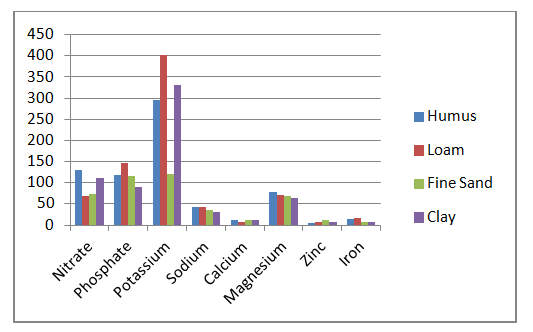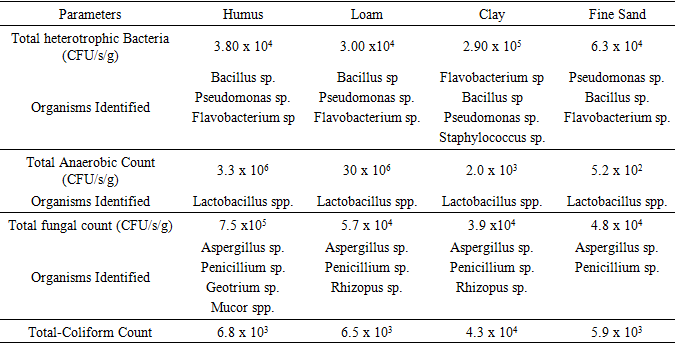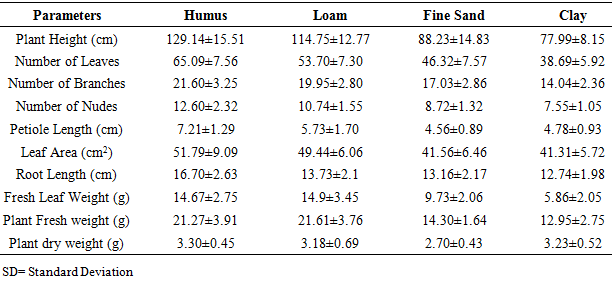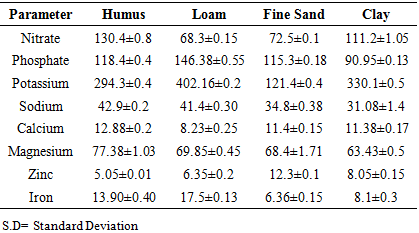-
Paper Information
- Paper Submission
-
Journal Information
- About This Journal
- Editorial Board
- Current Issue
- Archive
- Author Guidelines
- Contact Us
International Journal of Modern Botany
p-ISSN: 2166-5206 e-ISSN: 2166-5214
2020; 10(1): 9-14
doi:10.5923/j.ijmb.20201001.02

Mineral Analysis and Morphological Responses on the Seedling Growth of Telfairia occidentalis (Ugwu) on Four Different Soil Types
Oluwole Surukite O., Ogun Mautin L., Dajakpome Grace E.
Department of Botany, Lagos State University, Ojo, Nigeria
Correspondence to: Oluwole Surukite O., Department of Botany, Lagos State University, Ojo, Nigeria.
| Email: |  |
Copyright © 2020 The Author(s). Published by Scientific & Academic Publishing.
This work is licensed under the Creative Commons Attribution International License (CC BY).
http://creativecommons.org/licenses/by/4.0/

Telfairia occidentalis (Ugwu) is a commonly consumed vegetable in West Africa especially Nigeria and it is highly sorted for. It is against this that this study tends to determine the mineral analysis and morphological responses of the seedling growth of Telfairia occidentalis on four different soil types. The experiments were carried out on in the screenhouse under uniform natural conditions at the department of botany, Lagos state university. Different soil types viz: humus, loam, clay and fine sand were collected and analysed for soil compositions and mature seeds were sown on each soil respectively. Morphological data and mineral analysis were done on each sample and the data collected were analyzed. The results showed differences in mineral compositions and growth performance of Telfairia occidentalis seedlings on different soil types. The plant height (129.14±15.51), number of leaves (65.09±7.56), number of branches (21.60±3.25), number of nudes (12.60±2.32), petiole length (7.21±1.29), leaf area (51.79±9.09) and root length (16.70±2.63) favoured seedlings planted in humus soils followed by those in loam soils while fine sand and clay soils are similar. Also, the mineral compositions of seedlings in both humus and loams are better than those in fine and clay soils. It therefore concludes that, humus and loam soils are better soils for the cultivation and contains good minerals needed for consumptions of Telfairia occidentalis.
Keywords: Loam soil, Clay soil, Humus Soil, Fine Sand Soil, Telfairia occidentalis, Morphological characters, Mineral-compositions
Cite this paper: Oluwole Surukite O., Ogun Mautin L., Dajakpome Grace E., Mineral Analysis and Morphological Responses on the Seedling Growth of Telfairia occidentalis (Ugwu) on Four Different Soil Types, International Journal of Modern Botany, Vol. 10 No. 1, 2020, pp. 9-14. doi: 10.5923/j.ijmb.20201001.02.
Article Outline
1. Introduction
- Soil is of the most important natural resources and a major factor in global food production. There has been innate interest in the soil and land quality since the advent of agriculture. The soil characteristics below the ground are recognized as possible key factors affecting plant species coexistence and community organization [1]. Thus, Gopal [2] defined soil as a thin layer of the earth’s crust which serves as a natural medium for the growth of plants. Soil structure affects the behaviour of plants in many ways. The most obvious effect is on the appearance of the roots, which are generally smooth and cylindrical in friable soil, but are stubby and gnarled in compacted soil and are greatly restricted in their range, with potentially deleterious effects on the supply of water and nutrients [3]. This soil varies in types, structure, texture, nutrient composition and water holding capacity. Abdulazeez [4] described soil texture as the 'feel' of a soil, or as the relative proportions of sand, silt, and clay in the soil. When they are wet, sandy soils feel gritty, silt soils feel smooth and silky, and clay soils feel sticky and plastic, or capable of being molded [4]. Soils with a high proportion of sand are referred to as 'light', and those with a high proportion of clay are referred to as 'heavy' [4]. The names of soil texture classes are intended to give an idea of textural make-up and physical properties of soils. The three basic groups of texture classes are sands, clays and loams [4]. A soil in the sand group contains at least 70% by weight of sand, a soil in the clay group contains at least 35% - 40% clay and, a loam soil is a mixture of sand, silt and clay particles that exhibit light and heavy properties in about equal proportions. The basic soil group names comes last in the class name, thus loam sand is in the sand group, and sandy loam is in the loam group [4]. The characteristics of soil play a big part in the plant’s ability to extract water and nutrients. If plants are to grow to their potential, the soil must provide a satisfactory environment for plant growth. Plants obtain oxygen and carbon from the air by photosynthesis. Soil provides the place for plants roots to anchor and grow. Soil holds the water in which the soil plant nutrients are changed into ions, which are in the forms that the plants can use. It holds the air space that prevents the plant from becoming waterlogged; it holds the chemicals that determine soils pH, salinity and dispersivity [5]. According to Abdulazeez [4], clay soil is sticky, plastic and easily mouldable in to shapes when wet. Air and water do not move easily within them. Clay particles tend to aggregate into lumps which get very hard as they dry out. Thus clay soils are heavy to work with, drain poorly, very hard for root to penetrate and seed to germinate [4]. Clay soil is potentially rich in plant nutrients; however, because of poor drainage, these nutrients are often withheld from the plants. Loamy soils are 'all round' soils and may be used to grow most crops [4]. They have the advantages of clay soils in that they retain plant nutrients yet, they also have the drainage of sandy soils. They are easy to cultivate, easy for root of plants to penetrate and ideal for seed germination [4]. Sandy soils are well aerated, light and easy to work with, they allow viable seeds to germinate easily and easy penetration of roots, but they have the disadvantages of being hungry soils, because nutrients are easily leached away by drainage. Water drains easily and rapidly through sandy soils [4].Crop's production may be affected by various environmental factors including both biotic and abiotic factors [6]. Soil type is one of the essential abiotic factors which might affect plant's growth through altering the function of plant roots and soil borne microbes such as root --endophytic fungi, mycorrhizal fungi, rhizobia, and plant growth-promoting microorganisms [7,8,9]. However, most plants including Telfairia species requires good soil for it to flourish.Telfairia occidentalis is a well known annual vegetable belonging to the cucurbitaceae family. It is a tropical vine grown in West Africa as a leafy vegetable [10,11]. Common names are fluted pumpkin, fluted gourd, Ugwu (Igbo Language) and Ikong-ubong (Efik/ Ibibio Language). Telfairia occidentalis is indigenous to southern Nigeria but can be grown in other parts of the country and other West and Central African Nations [12]. T. occidentalis is a perennial, dioeciously herb climbing by coiled, often branched tendrils to a height of more than 20m, root system ramifying in the top surface of the soil, stems are angular, glabrous, becoming fibrous when old. Leaves are arranged spirally, pedately compound with 3-5 leaflets, stipules absent, petiole (2-)4-11(-15) cm long, leaflet with petiocules 0.5-3.5cm long, central one largest, up to 15(-19) cm x 10 (-12) cm. Flowers are numerous, cream coloured, pedicel up to 4cm long, receptacle is campanulate with sepals and petals triangular and free-oblong and fringed in nature. Telfairia occidentalis is usually propagated by seeds; seeds are compressed ovoid, up to 4.5cm long, black or brown-red. Seedling with hypogeal germination, developing first a tap root and then numerous, spreading axillary roots; epicotyls are 5-12 cm long; cotyledons are plano-convex and fleshy. It does well in heavy rainfall areas and, late planting does not favour Telfairia occidentalis production because dry season will not allow extension of the period of crop production [12,13]. The nutritional value of Telfairia occidentalis, be it seeds or leaves makes a center of attraction to vegetable eaters. It has been reported that the seed contains higher fats (53%) and crude protein (27%) which justifies its wide consumption [12,14]. Also, it has been reported to contain excellent amino acids of about 93. 7% compare to those in soya beans. Potassium and sodium contents are also found in a considerable amount [15,16]. This justifies that Telfairia occidentalis seed cakes is suitable food that can fortifies other foods. The leaves are often cooked alone or together with okra as soup delicacies. The oil from the seeds of Telfairia occidentalis are often used as cooking oil. The rind and pulp of the fruit of fluted pumpkin are used as fodder for livestock [17,18]. Pregnant women and patients suffering from anaemia use leaf juice to strengthen blood. The stems are macerated to produce fibres that are used as a sponge [12]. In some cases, Telfairia occidentalis provides high appreciable cash income to small scale farmers and their families [19]. Previous studies have shown that different plants such as trees and shrubs (vegetables) especially Telfairia occidentalis species requires a good soil to do better. Also, plants generally play important roles in maintaining the ecological environments in order to ensure ecosystem functioning [20]. Thus, this study was designed to explore the Mineral analysis and morphological responses on the seedling growth of Telfairia occidentalis (Ugwu) grown on four different soil types and to determine the best soil suitable for it growth.
2. Materials and Methods
- Collection of Plant MaterialsExperiments were carried out in Botanical Garden, Department of Botany, Faculty of Science, Lagos State University, Ojo, Lagos, Nigeria for the periods of two months. Mature seeds of Telfairia occidentalis were obtained Lagos State Agricultural Input Supply, Agric Bus-stop, Ojo-Lagos, Nigeria. The soil samples were collected from different locations: Clay- Post Service area, Lasu Ojo; Fine Sand- behind the New science Complex, Lasu Ojo; Loam- Homes and Garden designs, Village Bus Stop along Lasu-Isheri road; and Humus- Ikesan, Igando, Lagos Nigeria. Each of the soil samples was analyzed at ISI Laboratory at Ikeja, Lagos, Nigeria and the soil compositions determined (Tables 1 and 2).
|
|
3. Results and Discussion
- Effects of different Soil types on the Morphological CharactersIn this study, morphological responses on seedlings of Telfairia occidentalis to different soil types showed significant variation in growth performance. Table 3 showed that Telfairia occidentalis grown on humus and loamy soils had better morphological responses than those other seedlings in other soil types. This is followed by those seedlings in clayey soils with sandy soil having the least performance (Table 3). This could be as a result of both humus and loamy soils having good soil properties and microbial loads than others (Tables 1 and 2). The results confirmed the finding of Odiaka [22], when it reported that the Telfairia occidentalis grown in clayey soil were less healthy and stayed considerably shorter in height, root length, shoot length and leaf areas compared to those grown in humus and loam soil respectively. Ayalew [23], also supported the results when he said seedlings on humus and loam soils performed better because the soils has good soil properties and organic matters with good considerable soil microbial compositions. It was also observed that the root length of Telfairia occidentalis grown in clayey soil had fewer roots. This finding also agreed with work of Abdulazeez [24] when he studied the effects of soil texture on vegetative and root growth of Senna obtusifolia seedlings indigenous to Bichi, Sudan savannah of Northern Nigeria, in greenhouse conditions. He reported that humus and loamy soils supported the growth of the plants because humus and loamy soils had the highest Organic Matter and Nitrogen, also had the highest proportions of Phosphorous and Potassium. Conversely, the sandy soil exhibited the second best performance, while clayey soil had the least performance (Table 3). Reduction in fresh and dry weights was also observed in relation to soil types with fine sand having the least weights. This agreed with the work of Onwueme et al. [25], when they reported reduction in both fresh and dry weights of Thymus vulgaris gown in different soil types for two seasons. In comparison, morphological characters of seedlings in terms of Plant Height (cm), Number of Leaves, Number of Branches, Number of Nudes, Petiole Length (cm), Leaf Area (cm2), Root Length (cm), Root Length (cm), Fresh Leaf Weight (g), Plant Fresh weight (g) and Plant Fresh weight (g) are significantly higher in humus soil compared to other soils, which continued in a decreasing order from humus to loam, fine sand and clay soils respectively (Table, Figure 1). This finding agreed with findings of Oluwole et al. [26].They reported that, this was as a result of different properties and microbial load of the soil. These properties include soil porosity, moisture content, and soon as reported in Table 1. This result further agreed with findings of Hwang et al. [9]. They reported that soil types have some impacts on Plant growth especially fresh weights of plant parts; thus, promoting microorganisms found in the root region, increase plant nutrients and water uptake efficiencies, and production of plant hormones. It also affects plants' shoot and root biomass, nutrient uptake efficiencies, and plant chemical contents.
|
 | Figure 1. Comparison of Mean Morphological characters of Telfairia occidentalis from different Soil types |
|
 | Figure 2. Comparative Mean mineral concentration (mg/Kg) of Telfairia occidentalis from different soil types |
4. Conclusions
- It is clear from the findings of this study that, effects of different soil types proved responsive and seedlings of Telfairia occidentalis are sensitive to it in terms of their morphological characters. This can be used as indicator of soil quality. However, it was found that seedlings of Telfairia occidentalis grown in both humus and loamy soils had better growth performance. More so, higher mineral compositions were found in seedlings grown in humus and loamy soils compared to other soil types. It could therefore be recommended that, farmers looking for more yields in production of Telfairia occidentalis should consider humus and loamy soils as the best soil types because they contains the best soil properties and considerable microbial loads. Also, for the consumption of the vegetable, those grown in humus and loamy soils are the best in good mineral composition needed by the body.
ACKNOWLEDGEMENTS
- Authors extend gratitude to Prof. Osonubi, O. And Mr. Sanni, A. A for their scholarly and technical advice during the compilation of the manuscript, and lastly to our anonymous reviewers for their editorial insights.
 Abstract
Abstract Reference
Reference Full-Text PDF
Full-Text PDF Full-text HTML
Full-text HTML


